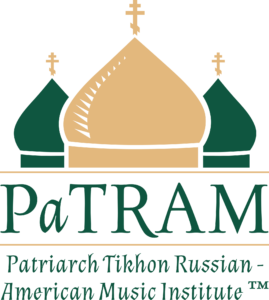Russian News: Moscow Workshop Participant Speaks with Pravoslavie.ru
On September 27 we posted an interview with Benedict Sheehan, choirmaster at St. Tikhon’s Monastery and Seminary in Pennsylvania, in which he shared his thoughts on the state of Church music in America and about the various projects with which he is involved. One of those projects is the Patriarch Tikhon Russian-American Music Institute (PaTRAM) which is dedicated to promoting high-quality Church singing, through private instructions and also through Master Classes throughout America. September 2—6 the institute offered its first Master Class in Russia, at the Trinity-St. Sergius Lavra Podvoriye in Moscow, where Institute co-founder Maestro Vladimir Gorbik, of whom Benedict spoke, is choirmaster. Singers from America, Canada, and Russia came together for an intensive workshop in Slavonic choral music, as well as several pilgrimage-outings, under the direction of Maestro Gorbik.
We spoke with Isaac Crabtree of St. John Chrysostom Orthodox Church in House Springs, MO, one of the thirty-five participants in the Master Class, about the experience. His thoughts and reflections are a testament to the work of PaTRAM and give us insight into the depth of the Orthodox choral tradition, and what can be accomplished both technically and spiritually when we give our best effort and our first fruits to the Lord.
* * *
Give us a run-down of the daily schedule of the conference.
This was a four-day Master Class, Wednesday—Saturday, that also included several planned excursions to holy places. Our final practice was on Saturday afternoon and we sang the Vigil at the Podvoriye Saturday evening, and the Divine Liturgy on Sunday. Each day was scheduled differently, but all were a combination of rehearsals or divine services and either planned or informal excursions.
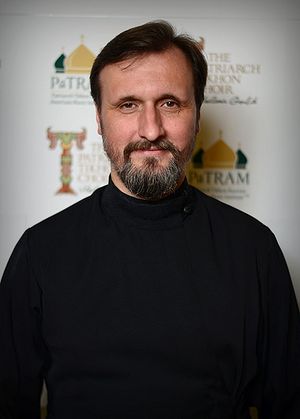
Maestro Vladimir Gorbik
For those who know Maestro Gorbik, he can have a reputation of being pretty strict and tough. What was it like working with him? Was it very different from working in a Church choir in America?
I am very pleased to answer this question, because I too had heard of his reputation. Maestro Gorbik told us at the outset that our class was like a journey up a steep mountain. His goal was to lead us up the mountainside, to that beautiful view. Only he among us gathered had seen how beautiful the view is at the top of this mountain, and only he knew the best way to get there. It was necessary, then, to follow him and accept his help when we fell down or got lost. This help, at times, took the form of mild corrections. Should we expect that someone who has dedicated his life to the millennium-long sacred tradition of Russian chant to have a casual attitude toward how we sing?
I think all of us understood that his corrections and admonitions were given to motivate us and perhaps also to humble us. After all, without humility and a willingness to struggle, real progress is impossible, in singing or in anything else. A few times, after some particularly difficult work or after some correction, he would tell us that he loved us. I think he said this every day of rehearsal. He didn’t say it in some silly or meaningless way, but in a truly spiritual way that also made us love and respect him. He demonstrated by his example that being truly kind, truly humble, truly loving, is not at all the same as being superficially “nice.” His strictness was a loving, fatherly strictness. His corrections were never humiliating, but motivated us to greater levels of musicianship. There was so much spiritual wisdom to his approach.
This conference was open to people of any level of musical ability. Was it a great struggle to bring such a diverse group together cohesively? How was this accomplished?
You’ve chosen the right person to answer this question. I found myself, a complete amateur, to be in the company of some truly excellent Orthodox American musicians, including the young and amazing tenor Adrian Fekula, already an accomplished ecclesiastical choir director himself in New York, from a family of distinguished musicians; Alexi Lukianov and Kelley Cossey, bassos profundo who took our sound into another dimension; Alexandra Pavuk, an incredible singer, composer and a music major; and my own choir director Constantine Stade, a music B.A., a quite experienced singer, and an authority in North America for the installation and ringing of bells in the Russian Orthodox tradition. Thankfully, though, I was not the only amateur. This was a class for everyone.
We arrived as individual musicians and were transformed through these classes into a choir. What can do this? I think the music itself gave me the answer. As the male choir was rehearsing Archimandrite Matfei’s Сподоби Господи (“Vouchsafe, O Lord”) the power of the music left this indelible impression on my soul: Тебе подобает хвала, Тебе подобает пение, Тебе слава подобает … climbing up to this amazing crescendo and heavenly chord. Truly, to Thee is due praise, to Thee is due a song, to Thee glory is due! Maestro Gorbik’s class showed me that there is a heavenly glory you can taste in sacred music when one executes it properly, and it becomes transformative. I think as we all began to experience this for ourselves the easier it became to sing and pray as one, or perhaps our unity led to the experience, or both.
He is also known for emphasizing the connection, which he argues is necessary, between musical excellence and a real, lived spiritual life. Was this something that you felt coming across from him?
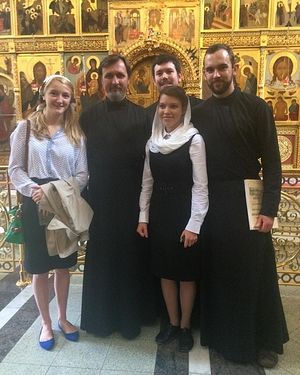
Isaac (back) with Maestro Gorbik and other participants of the Master Class
Unequivocally I did. Maestro Gorbik taught us this both by his words and his example. I felt like so much of what I learned was not merely about how to sing, but how to pray.His classes were captivating. The rehearsal time seemed to fly by every day. Several times he stopped us, not in order to discuss our singing but to teach us something about the inner spiritual realities of the sacred music.
For instance, once he mentioned to us a legend that says that vocal music was taught to the world by Abel, while instrumental music was given to the world by Cain. Whether literally true or not, I was struck by it because it is clearly saying something about music as an offering to God. We know that Abel’s offering was accepted, while Cain’s was not found to be worthy of God. I really got the impression that Maestro Gorbik saw the sacred music as an offering, a sacrifice—far more than a mere performance.
How has your understanding of Church music and singing in Church changed or developed through this experience?
I used to believe that, while Church singing should be done clearly and prayerfully, too much attention to the aesthetic aspect of the performance made it somehow less spiritual. I no longer believe this. The class showed me that with music, as with everything we do, what matters is the heart’s intention. Church music is another kind of iconography. Just as an iconographer strives to represent the exceeding radiance and superlative spiritual beauty of the Lord and His Most Pure Mother in the images he paints, we should always be striving to offer the very best to Christ in our singing. The widow in the Temple gave only two mites, but it was everything she had. Like her, we singers ought to give everything we have. This intention transfigures our labors to improve the execution and beauty of the music into something very spiritual. I really think that both Maestro Gorbik and the efforts of the other singers shook me out of my complacency and challenged me to become much more serious and intentional about how I sing.
Do you feel the group accomplished the goals initially set for the conference?
The goals, as I understood them, were to train a group of American musicians in the several pieces chosen, so that we actually sounded not only like a professional choir, but like a professional Russian Orthodox choir. I am in no position myself to judge this, but Maestro Gorbik told us afterwards that the monastery was very pleased with us. Others of the faithful in attendance also expressed their great appreciation. Maestro Gorbik himself also congratulated us on a job well done. This was enough for me.
As you said, the group was also taken on several excursions to churches and monasteries. Tell us about that. What impression did these holy places leave on you?
It was an experience of Holy Russia. On one day we visited the Kremlin, with its sacred temples where the Tsars were coronated and buried. It was such a gift to pray for my children before the relics of the child-martyr St. Dmitri. One cannot see the very place in Uspensky Sobor where the Vladimir Icon of the most holy Mother of God used to be, where the Orthodox Tsars were anointed with holy chrism, and remain unmoved.
On Friday evening several of us went to Vigil at Sretensky Monastery. This was the fulfillment of another dream of mine. I have read Everyday Saints three times, and have bought several copies for my friends. To be in the place associated with Archimandrite Tikhon was such a blessing. It was heaven on earth to hear such a beautiful and prayerful choir and to pray at this service with my American friends.
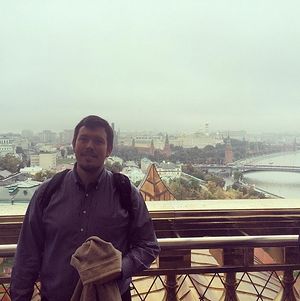
Atop Christ the Savior Cathedral
On Saturday we were given a private tour of the Cathedral of Christ the Savior by none other than the Archpriest Leonid (Kalinin) who was in charge of its reconstruction. We were able to first attend Divine Liturgy in the lower church of the Transfiguration, and then to go into the main temple to venerate sacred relics such as the head of St. John Chrysostom, the heavenly patron of my own parish in Missouri. Archpriest Leonid told us about the meaning of Christ the Savior Cathedral, about how it represented the victory of the Church (and consequently, of Russia) over atheism. This was why the Bolsheviks destroyed it, and why it was so important that it be rebuilt during the spiritual resurrection of Russia. He told us about that bitterly cold feast of the Nativity when the Patriarch said the blessing on the hallowed ground for the temple’s reconstruction, and how a heavenly fire descended and rested upon that place.
PaTRAM saved the best of the excursions for last. On Sunday after Divine Liturgy at the Podvoriye church we took a bus to Trinity-St. Sergius Lavra. We were there on the very day of the Mother of God’s appearance to St. Sergius and his disciple. We were in the very place that this happened. The monks had removed the glass covering from the relics of St. Sergius and I venerated the shroud covering the holy face of the father of Russian monasticism, and the Russian Church’s foremost ascetic, intercessor, and wonderworker.
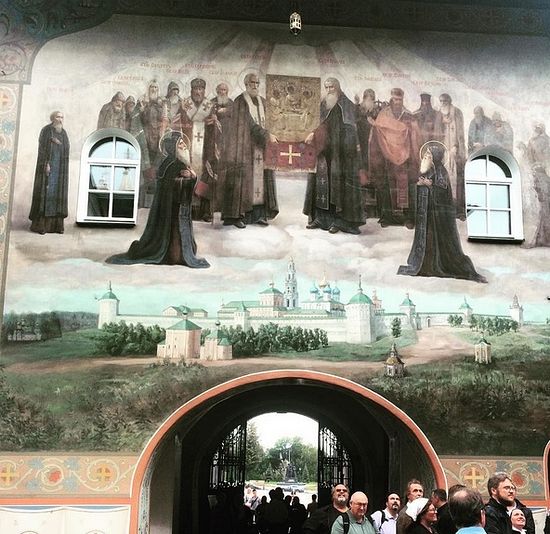
The gate of the Trinity-St. Sergius Lavra
I remember that in preparation for this trip I read the account of the appearance of the most holy Mother of God with the Apostles Peter and John to St. Sergius and his disciple. As he felt Her approaching, he told his disciple, “Come child, and we shall have a wondrous visit.” It felt like the saint was saying that to each of us—that his prayers brought us to Moscow to experience the spiritual power of Orthodoxy in that place. Returning through the Lavra’s gates, something prompted me to go to one of the icons of the holy parents of St. Sergius, and beg them to let me return to this place one day with my family.
Do you feel that your own spiritual life has developed by this experience?
I almost answered such a personal question with a laconic “Yes,” and moved on to the next one! That didn’t feel right to do in an interview for my favorite Orthodox website.
I’ll just tell you that I feel like one of the emissaries that St. Vladimir sent to the Greeks in the tenth century, and can say with them, “We knew not whether we were in Heaven or on earth. For on earth there is no such splendor or such beauty, and we are at a loss how to describe it. We know only that God dwells there among men … for we cannot forget that beauty.” Nothing can ever be the same for me.
What is the most memorable part of the trip for you?
I’ve already recounted some of them, so I’ll add just one last one: an epiphany during the Divine Liturgy. As I listened to us all singing Divine Liturgy with Vladimir Gorbik, on the feast of All Saints of Moscow, at the Podvoriye of Trinity-Sergius Lavra, surrounded by the holy fathers and the faithful, standing at the kliros before the icon of the holy Royal Passion-bearers, I remembered Maestro Gorbik’s mountain analogy from the beginning of our class. It occurred to me then that only as we reached the summit of this mountain was it revealed to be none other than Mount Tabor: Lord, it is good for us to be here.
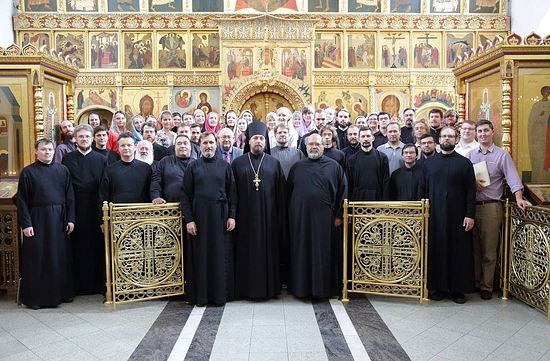
04 / 10 / 2015
